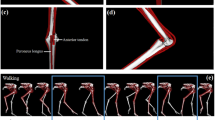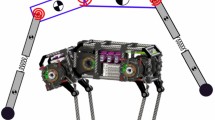Abstract
To look for the reason why the biped animal in nature can run with such high speed and to design a bionic biped prototype which can behave the high speed running and jumping ability, this paper takes the fastest bipedal animal in nature: ostrich as the research subject. Firstly, the body structure and motion characteristics of ostrich are investigated. Secondly, a simple mechanical structure of bionic ostrich robot is designed based on the above biological investigated results. The robot is under-actuated with one actuator each leg, with a spring on the tarsometatarsus and a torsion spring on the metatarsophalangeal joint at the foot end. And then the mechanical design of leg structure is optimized. Finally, the high-speed running and jumping running gait is planned, and comparative simulations are implemented with different design requirements among pure rigid and rigid-flexible coupling scheme, which are rigid, only with spring, only with torsion spring, and with spring and torsion spring both, in detail. Simulation results show that the rigid-flexible coupling design scheme and whole body motion coordination can achieve better high speed performance. It provides an insight for the design and control of legged robots.



















Similar content being viewed by others
References
Apgar T, Clary P, Green K et al (2018) Fast online trajectory optimization for the bipedal robot cassie. Robot Sci Syst 2:14
Kx B, Song Y, Yp S et al (2022) A novel one-dimensional force sensor calibration method to improve the contact force solution accuracy for legged robot. Mech Mach Theory 169(104):685
Ba K, Song Y, Wang C et al (2022) A novel kinematics and statics correction algorithm of semi-cylindrical foot end structure for 3-dof lhds of legged robots. Complex Intell Syst 2:1–21
Che J, Pan Y, Yan W et al (2021) Kinematics analysis of leg configuration of an ostrich bionic biped robot. In: 2021 international conference on robotics and control engineering, pp 19–22
Chen G, Guo S, Hou B et al (2020) Fractional order impedance control. IEEE Access 8(48):904–48,916
Chen G, Guo S, Wang J et al (2020) Convex optimization and a-star algorithm combined path planning and obstacle avoidance algorithm. Control Decis 35(12):2907–2914
Dafarra S, Bertrand S, Griffin RJ et al (2020) Non-linear trajectory optimization for large step-ups: Application to the humanoid robot atlas. In: 2020 IEEE/RSJ international conference on intelligent robots and systems (IROS), IEEE, pp 3884–3891
Feng S, Xinjilefu X, Atkeson CG et al (2015) Optimization based controller design and implementation for the atlas robot in the darpa robotics challenge finals. In: 2015 IEEE-RAS 15th international conference on humanoid robots (Humanoids), IEEE, pp 1028–1035
Haijin W (2019) Bionic research in foot of mechanical leg travelling on sand based on biological assemble characteristics of ostrich foot. MSc thesis, Jilin University
Haitao W (2017) Biomimetic research in athletic shoes’ cushioning midsole based on superior cushioning characteristics of ostrich foot toepad. MSc thesis, Jilin University
Han D, Zhang R, Yu G et al (2020) Study on bio-inspired feet based on the cushioning and shock absorption characteristics of the ostrich foot. PLoS ONE 15(7):e0236,324
Han D, Zhang R, Cao Q et al (2021) Research in mechanical model of bionic foot intruding into sands with different physical characteristics. J Terramech 2:778
Hartley R, Ghaffari M, Eustice RM et al (2020) Contact-aided invariant extended kalman filtering for robot state estimation. Int J Robot Res 39(4):402–430
Ji Q, Qian Z, Ren L et al (2021) Torque curve optimization of ankle push-off in walking bipedal robots using genetic algorithm. Sensors 21(10):3435
Lefkeli D, Ozbay Y, Gürhan-Canli Z et al (2021) Competing with or against cozmo, the robot: influence of interaction context and outcome on mind perception. Int J Soc Robot 13(4):715–724
Lei L (2019) Research in compliant bionic joint based on the loading and motion characteristics of ostrich intertarsal joint. MSc thesis, Jilin University
Mahdy EA, Abd El Raouf M (2020) Normal anatomical and diagnostic imaging techniques of the musculotendinous structures of the ostrich (struthio camelus) foot. J Adv Vet Animal Res 7(2):242
Pang H, Zhang H, Zhang R et al (2021) Design of the bionic wheel surface based on the friction characteristics of ostrich planta. Rendiconti Lincei Scienze Fisiche e Naturali 32(1):191–203
Pang H, Zhang R, Ge P et al (2021) 3d dem analysis on tractive trafficability of a lunar rover wheel with bionic wheel lugs. Rendiconti Lincei Scienze Fisiche e Naturali 32(2):377–387
Pontzer H, Holloway JH 4th, Raichlen DA et al (2009) Control and function of arm swing in human walking and running. J Exp Biol 212(4):523–534
Qiaoli J (2017) Research in bionic walking wheel of multi-posture casters based on kinematic characteristics of ostrich toes. MSc thesis, Jilin University
Schaller NU (2008) Structural attributes contributing to locomotor performance in the ostrich. PhD thesis, Universitatsbibliothek Heidelberg
Shen Z, Seipel J (2015) Animals prefer leg stiffness values that may reduce the energetic cost of locomotion. J Theor Biol 364:433–438
Shen Z, Seipel J (2015) The leg stiffnesses animals use may improve the stability of locomotion. J Theor Biol 377:66–74
Shi X, Gao J, Lu Y et al (2021) Biped walking based on stiffness optimization and hierarchical quadratic programming. Sensors 21(5):1696
Song Z, Jing Q, Chen Y et al (2015) The design and analysis of the bionic ostrich biped robots. In: 2015 international symposium on material. Atlantis Press, Energy and Environment Engineering, pp 574–576
Songsong M (2017) Bionic research in surface of traveling-sand wheel based on the adhesion property of ostrich planta. MSc thesis, Jilin University
Yuan H (2018) Bionic research in energy-saving and vibration-reducing mechanical leg based on hind limb of ostrich. MSc thesis, Jilin University
Zhang R, Wang H, Zeng G et al (2016) Anatomical study of the ostrich (struthio camelus) foot locomotor system. Indian J Anim Res 50(4):476–483
Zhang R, Ji Q, Luo G et al (2017) Phalangeal joints kinematics during ostrich (struthio camelus) locomotion. PeerJ 5:e2857
Zhang R, Han D, Luo G et al (2018) Macroscopic and microscopic analyses in flexor tendons of the tarsometatarso-phalangeal joint of ostrich (struthio camelus) foot with energy storage and shock absorption. J Morphol 279(3):302–311
Zhang R, Cao Q, Ling L et al (2020) Adaptive bionic joint base on the flexibility feature of ostrich intertarsal joint. J Phys Conf Ser 2:052007
Zhang R, Han D, Yu G et al (2020) Bionic research on spikes based on the tractive characteristics of ostrich foot toenail. Simulation 96(9):713–723
Zhang R, Pang H, Ji Q et al (2020) Structure design and traction trafficability analysis of multi-posture wheel-legs bionic walking wheels for sand terrain. J Terrramech 91:31–43
Zhang R, Pang H, Wan H et al (2020) Design and analysis of the bionic mechanical foot with high trafficability on sand. Appl Bionics Biomech 7:889
Zhang R, Li G, Ma S et al (2021) Frictional performance of ostrich (struthio camelus) foot sole on sand in all directions. Biomech Model Mechanobiol 20(2):671–681
Zhang R, Pang H, He Y et al (2021) Bionic design and simulation analysis of energy-efficient and vibration-damping walking mechanism [j]. J Harbin Inst Technol (New Ser) 28(4):16–24
Zhang R, Wang C, Fan S et al (2021c) Light and high-strength structure inspired by the characteristics of double-nutrient foramens in intertarsal joint of ostrich. Rendiconti Lincei Scienze Fisiche e Naturali, pp 1–9
Acknowledgements
This research was funded by National Natural Science Foundation of China (62103036) and Fundamental Research Funds for the Central Universities (2022JBMC025).
Author information
Authors and Affiliations
Corresponding author
Ethics declarations
Conflict of interest
The authors have no conflicts of interest to declare that are relevant to the content of this article.
Additional information
Publisher's Note
Springer Nature remains neutral with regard to jurisdictional claims in published maps and institutional affiliations.
Rights and permissions
Springer Nature or its licensor holds exclusive rights to this article under a publishing agreement with the author(s) or other rightsholder(s); author self-archiving of the accepted manuscript version of this article is solely governed by the terms of such publishing agreement and applicable law.
About this article
Cite this article
Chen, G., Wei, N., Li, J. et al. Design and simulation analysis of a bionic ostrich robot. Biomech Model Mechanobiol 21, 1781–1801 (2022). https://doi.org/10.1007/s10237-022-01619-9
Received:
Accepted:
Published:
Issue Date:
DOI: https://doi.org/10.1007/s10237-022-01619-9




